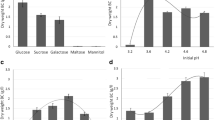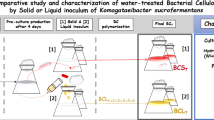Abstract
The saccharogenic liquid (SFW) obtained by the enzymatic saccharification of food wastes was used as a medium for production of bacterial cellulose (BC). The enzymatic saccharification of food wastes was carried out by the cultivation supernatant ofTrichoderma harziaum FJ1 culture.Acetobacter xylinum KJ1 was employed for the BC production culture. The physical properties, such as polymerization, crystallinity, Young's modulus, and tensile strength, of BCs produced by three culture methods: the static cultures using HS (Hestrin-Schramm) as a reference medium (A) or the SFW medium (B), the shaking culture (C) or the air circulation culture (D) using the SFW medium, were investigated. The degrees of polymerization of BCs produced under the different culture conditions (A∼D) showed 11000, 9500, 8500, and 9200, respectively. Young's modulus was 4.15, 5.0, 4.0, and 4.6 GPa, respectively. Tensile strength was 124, 200, 80, and 184 MPa, respectively. All of the BC had a form of cellulose I representing pure cellulose. In the case of the shaking culture, the degree of crystallinity was 51.2%, the lowest degree. Under the other culturing conditions, the trend should remain in the range of 89.7–84%. Overall, the physical properties of BC produced from SFW were similar to those of BC from HS medium, a commercial complex medium, and BC production by the air circulation culture mode brought more favorable results in terms of the physical properties and its ease of scale-up. Therefore, it is expected that a new BC production method, like air circulation culture using SFW, would contribute greatly to BC-related manufacturing.
Similar content being viewed by others
References
Klemm, D., D. Schumann, U. Udhard, and S. Marsch (2001) Bacterial synthesized cellulose-artificial blood vessels for microsurgery.Prog. Polym. Sci. 26: 1561–1603.
Shibazaki, H., S. Kuga, F. Onabe, and M. Usuda (1993) Bacterial cellulose membrane as separation medium.J. Appl. Poly. Sci. 50: 965–969.
Matsuoka, M., T. Tsuchida, K. Matushita, O. Adachi, and F. Yoshinaga (1996) A synthetic medium for bacterial cellulose production byAcetobactr xylinum subsp.sucrofermentans.Biosci. Biotechnol. Biochem. 60: 575–579.
Naritomi, T., T. Kouda, H. Yan, and F. Yoshinaga (1998) Effect of Lactate on bacterial cellulose production form fructose in continuous culture.J. Ferment. Bioeng. 85: 89–95.
Chao, Y., T. Ishida, Y. Sugano, and M. Shoda (2000) Bacterial cellulose production byAcetobacter xylinum in a 50-L internal-loop airlift reactor.Biotechnol. Bioeng. 68: 345–352.
Kim, K. C., S. S. Yoo, Y. A. Oh, and S. J. Kim (2003) Isolation and characteristics ofTrichoderma harzianum FJ1 producing cellulases and xylanase.J. Microbiol. Biotechnol. 13: 1–8.
Mandel, M. and D. Sternberg (1976) Recent advances in cellulase technology.J. Ferment. Technol. 54: 267–286.
Yoo, S. S., K. C. Kim, Y. A. Oh, S. Y. Chung, and S. J. Kim (2002) The high production of cellulolytic enzymes using cellulosic wastes by a fungus, strain FJ1.Kor. J. Microbiol. Biotechnol. 30: 172–176.
Kim, K. C., S. W. Kim, M. J. Kim, and S. J. Kim (2005) Saccharification of foodwastes using cellulolytic and amylolytic enzymes fromTrichoderma harzianum FJ1 and its kinetics.Biotechnol. Bioprocess Eng. 10: 52–59.
Son, C. J., S. Y. Chung, J. E. Lee, and S. J. Kim (2002) Isolation and cultivation characteristics ofAcetobacter xylinum KJ1 producing bacterial cellulose in shaking cultures.J. Microbiol. Biotechnol. 12: 722–728.
Hestrin, S. and M. Schramm (1954) Synthesis of cellulose byAcetobacter xylinum. 1. Micromethod for the determination of celluloses.Biochem. J. 56: 163–166.
Kuga, S., N. Muton, A. Isogai, M. Usuda, and R. M. Brown, Jr. (1989) Cellulose: Structural and function aspects, pp. 81–86. In: J. K. Kennedy, G. O. Phillips, and P. A. Williams (eds.) Ellis Horwood, Chichester, UK.
Alexander, W. J. and R. L. Mitchell (1949) Rapid measurement of cellulose viscosity by nitration methods.Anal. Chem. 21: 1497–1500.
Segal, L., J. Creely, A. Martin, and C. Conrad (1959) An empirical method for estimating the degree of crystallinity of native cellulose using the X-ray diffreactometer.Text. Res. J. 29: 786–794.
Annual Book of ASTM Standards, section 8, Plastics, ed. by ASTM, Pennsylvania (1993) Vol. 8.
Biochemistry Experimental Book, ed., pp. 258–259. Teaching Material Editing Committee of Korean Journal of Biochemistry, Tamgudang, Korea. 1994.
Park, J. K., S. H. Hyun, and J. Y. Jung (2004) Conversion ofG. hansenii PJK into non-cellulose-producing mutants acciording to the culture condition.Biotechnol. Bioprocess Eng. 9: 383–388.
Jung, J. Y., J. K. Park, and H. N. Chang (2005) Bacterial cellulose production byGluconaacetobacter hansenii in an agitated culture without living non-cellulose producing cells.Enzyme Microb. Technol. 37: 347–354.
Shoda, M. and Y. Sugano (2005) Recent advances in bacterial cellulose production.Biotechnol. Bioprocess Eng. 10: 1–8.
Yamamoto, H., F. Horii, and A. Hirai (1996)In situ crystallization of bacterial cellulose 2. Influences of different polymeric additives on the formation of celluloses I α and I β at the early stage of incubation.Cellulose 3: 229–242.
Watanabe, K., Y. Hori, M. Tabuchi, Y. Morinaga, F. Yoshinaga, F. Horii, J. Sigiyama, and T. Okano (1994) Structural features of bacterial cellulose vary depending on the culture conditions.Proceedings of '94 Cellulose R&D, 1st Annual Meeting of the Cellulose Society of Japan, pp. 45–50.
Nishi, Y., M. Uryu, S. Yamanaka, K. Watanabe, N. Kitamura, M. Iguchi, and S. Mitsuhashi (1990) The structure and mechanical properties of sheets prepared from bacterial cellulose.J. Mater. Sci. 25: 2997–3001.
Author information
Authors and Affiliations
Corresponding author
Rights and permissions
About this article
Cite this article
Moon, SH., Park, JM., Chun, HY. et al. Comparisons of physical properties of bacterial celluloses produced in different culture conditions using saccharified food wastes. Biotechnol. Bioprocess Eng. 11, 26–31 (2006). https://doi.org/10.1007/BF02931864
Received:
Accepted:
Issue Date:
DOI: https://doi.org/10.1007/BF02931864




